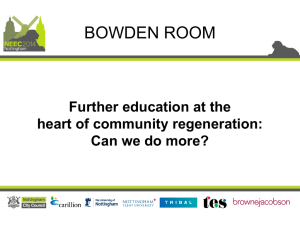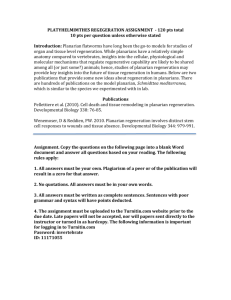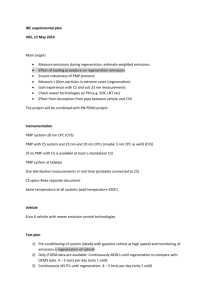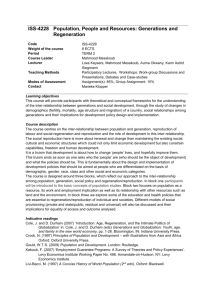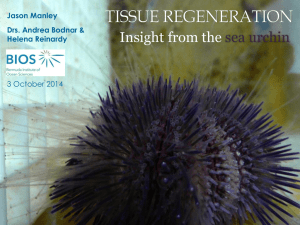Towards dihaploid production in sunflower - Selection of
advertisement
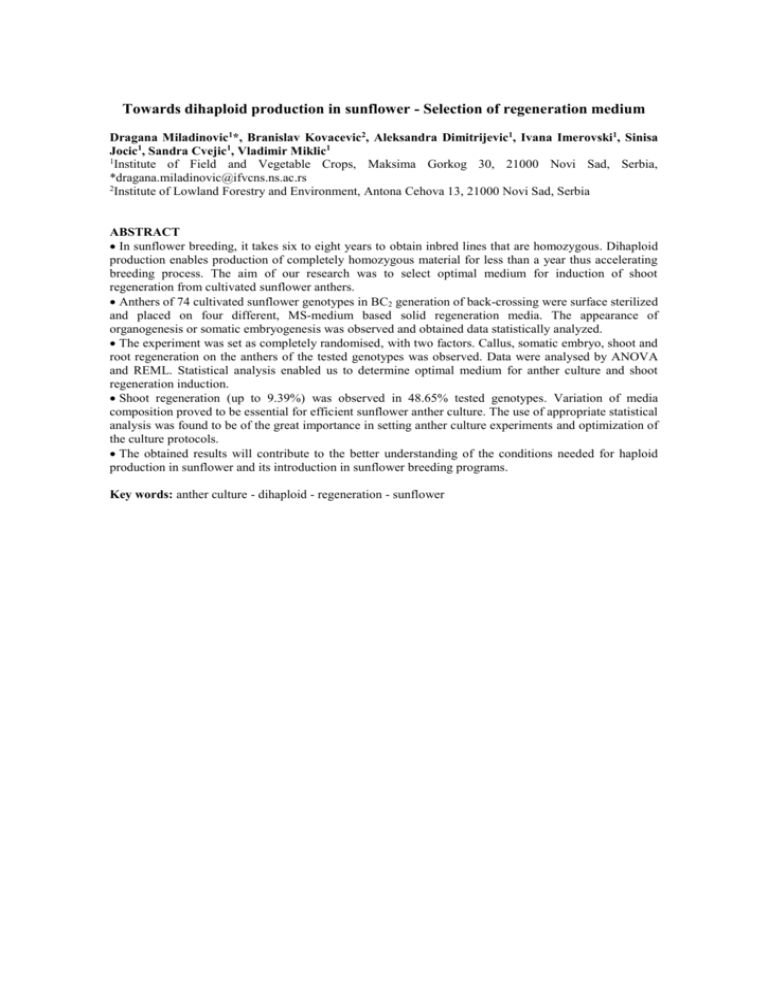
Towards dihaploid production in sunflower - Selection of regeneration medium Dragana Miladinovic1*, Branislav Kovacevic2, Aleksandra Dimitrijevic1, Ivana Imerovski1, Sinisa Jocic1, Sandra Cvejic1, Vladimir Miklic1 1 Institute of Field and Vegetable Crops, Maksima Gorkog 30, 21000 Novi Sad, Serbia, *dragana.miladinovic@ifvcns.ns.ac.rs 2 Institute of Lowland Forestry and Environment, Antona Cehova 13, 21000 Novi Sad, Serbia ABSTRACT In sunflower breeding, it takes six to eight years to obtain inbred lines that are homozygous. Dihaploid production enables production of completely homozygous material for less than a year thus accelerating breeding process. The aim of our research was to select optimal medium for induction of shoot regeneration from cultivated sunflower anthers. Anthers of 74 cultivated sunflower genotypes in BC2 generation of back-crossing were surface sterilized and placed on four different, MS-medium based solid regeneration media. The appearance of organogenesis or somatic embryogenesis was observed and obtained data statistically analyzed. The experiment was set as completely randomised, with two factors. Callus, somatic embryo, shoot and root regeneration on the anthers of the tested genotypes was observed. Data were analysed by ANOVA and REML. Statistical analysis enabled us to determine optimal medium for anther culture and shoot regeneration induction. Shoot regeneration (up to 9.39%) was observed in 48.65% tested genotypes. Variation of media composition proved to be essential for efficient sunflower anther culture. The use of appropriate statistical analysis was found to be of the great importance in setting anther culture experiments and optimization of the culture protocols. The obtained results will contribute to the better understanding of the conditions needed for haploid production in sunflower and its introduction in sunflower breeding programs. Key words: anther culture - dihaploid - regeneration - sunflower INTRODUCTION For commercial hybrid production, homozygous lines are of great importance. Anther and microspore cultures allow acceleration of breeding programmes by providing homozygous doubled haploids within a comparatively short time. Anther culture in sunflower (Helianthus annuus L.) still needs considerable improvement, as sunflower proved to be very recalcitrant in anther culture (Mezzarobba and Jonard, 1986) and the regeneration rates are very low. As in other species, anther culture response of sunflower is strongly affected by physical, nutritional, physiological and genetic factors (Gurel et al., 1991). That is why it is necessary to test a number of different culture parameters for the successful regeneration of shoots - at least for a number of sunflower lines and interspecific hybrids, as androgenic capacity in sunflower is found to be genotype dependant (Marinkovic et al., 2003). Regarding medium composition, different authors varied composition mostly of MS medium (Murashige and Skoog, 1962) in order to enhance the frequency of anther callusing and/or somatic embryogenesis and subsequent plant regeneration. Different compositions of media used for establishing anther culture were extensively reviewed by Friedt et al. (1997), and variation of other culture parameters by Nichterlein and Horn (2005). The aim of our research was to select optimal medium for induction of shoot regeneration from cultivated sunflower anthers. MATERIALS AND METHODS Anthers of 74 cultivated sunflower genotypes in BC2 generation of back-crossing were surface sterilized and placed on four different, MS-medium based solid regeneration media. Media were supplemented with basic MS macro and micro salts, 0.3% gelrite, pH 5.7, while composition of hormones varied (Vasic et al., 2000). Anthers were cultured in the dark at 30oC. The appearance of organogenesis or somatic embryogenesis was observed after fourth week of culture, and percentage of regenerated roots and shoots calculated. Obtained data were analyzed by ANOVA and REML using StatSoft 11. Controlled sources of variation, genotype, medium and their interaction, were treated as random effects in the statistical analysis. REML was used in order to quantify variance components of controlled sources of variation. LSD test for comparison of mean values was done. RESULSTS AND DISCUSSION Variance analysis showed that the all sources of variation had significant effect on callus, embryo and root formation, while the medium did not have significant effect on shoot regeneration (Table 1). This is in accordance with the results of other authors who found that regeneration in sunflower anther culture is highly genotype dependant (Nurhidayah et al., 1994; Thengane et al., 1994; Zhong et al., 1995; Vasic et al., 2000). Table 1. F values of all sources variation for callusogenesis, somatic embryogenesis, root and shoot regeneration Source Callusogenesis Somatic embryogenesis Root regeneration Shoot regeneration Genotype 5.75** 3.21** 2.30** 2.92** Medium 48.56** 3.99** 20.73** 1.94ns GxM 12.82** 3.12** 5.64** 2.96** ** - Significant at α0.05 and α0.01; ns - Not significant REML analysis showed that medium variance did not contribute significantly to the total variance, thus the effect of medium on observed traits could not be quantified (Table 2). However GxM interaction was high, which shows that there were significant differences in reaction of the tested genotypes to the media used. This further confirms the need to for the anther culture media improvement and their optimisation according to the requirements of the genotypes used (Marinkovic et al., 2003; Nichterlein and Horn, 2005). Table 2. REML analysis of variance components for callusogenesis, somatic embryogenesis, root and shoot regeneration Source Callusogenesis Somatic embryogenesis Root regeneration Shoot regeneration Genotype Medium GxM Error 509.38** 273.41ns 395.57** 100.36** 39.41** 2.88ns 48.39** 68.55** 30.40** 24.92ns 76.87** 49.66** 16.98** 0.46ns 23.36** 35.81** ** - Significant at α0.05 and α0.01; ns - Not significant Shoot regeneration (up to 9.39%) was observed in 48.65% tested genotypes. The highest number of genotypes (36.49%) regenerated plants on A medium supplemented with hormones favouring the callus regeneration (Vasic et al., 2000). This medium had the highest percentage of somatic embryo, root and shoot regeneration. Initial callus formation was significantly higher in B medium than in other tested media (Table 3), but it did not lead to high shoot regeneration, since only 18.92% of genotypes regenerated shoots on this medium. The lowest percentage of somatic embryo regeneration was observed in C and D media, which had medium and sugar composition adapted for somatic embryo induction (Vasic et al., 2000). Shoot regeneration on these two media was also low (Table 3). Table 3. LSD test for percentage of callusogenesis, somatic embryogenesis, root and shoot regeneration Medium Callusogenesis % Somatic embryogenesis % Root regeneration % Shoot regeneration % A 61.60b 3.38a 4.57a 0.66a B 78.07a 2.14b 3.95a 0.28b C 16.63d 1.21c 0.24b 0.21b D 35.58c 1.35c 0.32b 0.22b The values within the same column marked with different letters differed significantly at α 0.05 Regarding contribution of components of variance to the total variance, genotype had the highest effect on callus formation since its variance contributed to 50% of total variance (Figure 1). The effect of genotype and interaction was similar for embryo formation, as their variances contributed approximately to 25% of total variance each. Interaction had the highest effect on root and shoot regeneration, contributing to 45% and 30% of the total variance, respectively. 100% 80% Error 60% Interaction 40% Medium Genotype 20% 0% Calluses Embryos Roots Shoots Figure 1. Contribution of expected variances of tested variation sources to the total variance (%) The obtained results indicate that genotype plays an important role in initial establishment of sunflower anther culture, bat that interaction GxM is more important in the subsequent culture and shoot regeneration induction. Although some promising results regarding sunflower anther culture were obtained (Nurhidayah et al., 1996), further research is needed for optimization of haploid production for the use in sunflower breeding. Regeneration percentage is relatively low and depends on genotype (Marinkovic et al., 2003). The results obtained in our study will contribute to the better understanding of the conditions needed for haploid production in sunflower and its introduction in sunflower breeding programs. The use of appropriate statistical analysis was found to be of the great importance in setting anther culture experiments and optimization of the culture protocols, as it helped us to establish the importance of different variance components and their interaction in different stages of anther culture. Further studies should be focused on medium composition variation, as well as optimisation of donor plants growing conditions in order to elucidate the nature of genotype effect and overcome strong effects on the environment on sunflower androgenic potential. ACKNOWLEDGMENTS This work was supported by Ministry of Education and Science, Republic of Serbia, project TR 31025. REFERENCES Friedt, W., Nurhidayah, T., Rocher, T., Kohler, H., Bergmann, R., and R. Horn. 1997. Haploid production and application of molecular methods in sunflower (Helianthus annuus L.). p. 17-35. In: S.M. Jain (ed.), In vitro haploid production in higer plants. Kluwer Academic Pubishers, Amsterdam, The Netherlands. Gurel, A., Nichterlein, K., and W. Friedt. 1991. Shoot regeneration from anther culture of sunflower (Helianthus annuus L.) and some interspecific hybrids is affected by genotype and culture procedure. Plant Breed. 106: 68-76. Marinković, R., Dozet, B., and D. Vasić. 2003. Sunflower breeding. Školska knjiga, Novi Sad, Serbia. Mezzarobba, A., and R. Jonard. 1986. Effets du stade de prelevement et des pretraitements sur le developpement in vitro d'antheres preleves sur le tournesol cultive (Helianthus annus L.). CR Acad. Sci. Paris 303:181-186. Murashige, T., and F. Skoog. 1962. A revised medium for growth and bioassays with tobacco tissue cultures. Physiol. Plant. 15:473-497. Nichterlein, K., and R. Horn. 2005. Haploids in the improvement of Lineaceae and Asteraceae. p. 277291. In: C.E. Don Palmer, W.A. Keller, K.J. Kasha (eds.) Haploids in crop improvement II. SpringerVerlag Berlin Heidelberg, Germany. Nurhidayah, T., Kohler, H., Dahlhoff, M., and W. Friedt. 1994. Anther culture of interspecific sunflower hybrids and examination of regenerants by biochemical and molecular methods. Biotechnol. Biotechnol. Eq. 7:113-116. Nurhidayah, T., Horn, R., Rocher, T., and W. Friedt. 1996. High regeneration rates in anter culture of intersepcific sunflower hybrids. Plant Cell Rep. 16:167-173. Thengane, S.R., Joshi, M.S., Khuspe, S.S., and A.F. Mascarenhas. 1994. Anther culture in Helianthus annuus L., influence of genotype and culture conditions on embryo induction and plant regeneration Plant Cell Rep. 13:222-226. Vasić, D, Škorić, D., and S. Jocić. 2000. Anther culture of sunflower cultivars. p. L-52-55. In: Proc. 15th Int. Sunfl. Conf., Toulouse, France. Int. Sunfl. Assoc., Paris, France. Zhong, D., Michaux-Ferriere, N., and M. Coumans, 1995. Assay for doubled haploid in sunflower (Helianthus annuus) plant production by androgenesis : fact or artefact? Part 1. In vitro anther culture. Plant Cell Tissue Org. Cult. 41:91-97.


